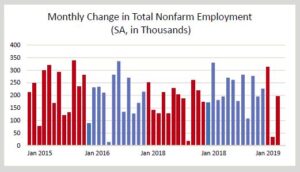Written by Kim Kennedy, Director of Forecasting on April 8, 2019
Construction economics – Nonfarm payrolls grew by 196,000 in March, putting to rest concerns that the labor market – and by extension the entire economy – is reaching the end of its long expansion. February’s job growth was revised upward by 13,000 to 33,000 jobs and January’s strong pace was also revised upward by 1,000 to 312,000 jobs. It now seems that the dramatic February slowdown in job growth was (as expected) an anomaly, rather than the beginning of the end. It’s also not the first anomaly of this expansion in construction economics. In fact, job growth has paused twice before over the past few years – growing by just 15,000 in May 2016 and by just 18,000 in September 2017.

With the March gain in payrolls, the first quarter added an average of 180,000 jobs per month, a slowdown from the monthly average in 2018 (223,000 jobs per month), but consistent with the more moderate growth for both jobs and the economy expected in 2019. Job growth will inevitably slow this year given the low rate of unemployment (which constrains the supply of workers available to fill expanding job openings) and increasing wages (driven up by labor constraints), but also by conditions that are slowing overall economic growth such as the fading effects from last year’s stimulus – tax cuts in the Tax Cuts and Jobs Act and the boost in federal spending that came from passage of the Omnibus spending bill in March 2018.
The March employment gains came almost entirely on the services side of the labor market, rather than the goods side. Service employment rose by 184,000 last month, while goods-producing jobs rose by just 12,000. The strongest growth sectors included education/healthcare (up 70,000), professional and business services (up 37,000), and leisure/hospitality (up 33,000). Construction market payrolls improved modestly (up 16,000) after taking a large 25,000 hit in February. The manufacturing sector lost 6,000 jobs over the month.
The household survey showed a somewhat less optimistic view of the labor market as the number of people in the labor force fell by 224,000 over the month pushing down the labor force participation rate (share of the population either employed or looking for a job) to 63.0%. Still, the unemployment rate remained unchanged at 3.8%.
All told, this jobs report is reassuring that construction economics is not in danger of imminent decline, even if the bloom may be fading from the rose.
Looking for construction market forecasting for your business? Dodge can help. Learn more here.
